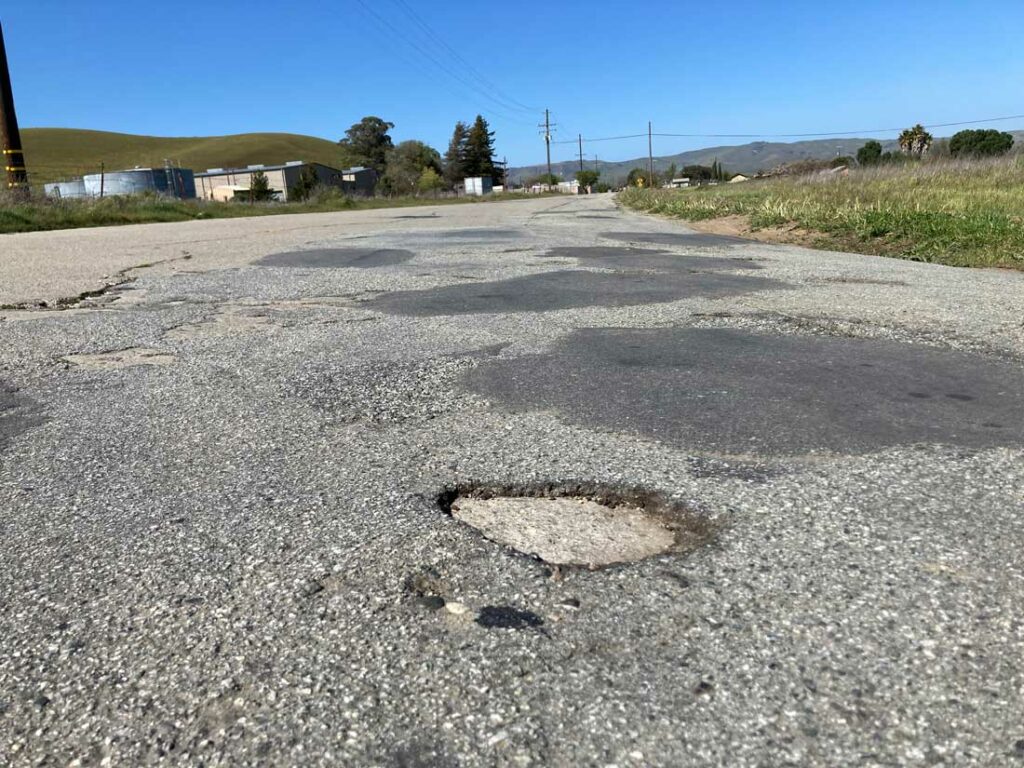City of Hollister and San Benito County officials are taking steps to speed up the repair and upgrades of local deteriorating roadways by allocating large sums of money for the efforts.
The Hollister City Council on March 21 approved the sale of $20 million in bond financing for capital improvements to the city’s roads and alleyways. The bonds will be reimbursed through a “lease-leaseback” structure using existing city properties, such as public parks or a fire station, according to city staff.
Mayor Ignacio Velazquez said the bond funding will contribute to a total of about $30 million available for road infrastructure repairs and upgrades over the next 18 months, with funds from Measure G, SB 1 and gas taxes making up the difference. He added that the city and county will likely team up on some of the forthcoming projects.
“We have been talking the last year and a half about partnering on roads that affect our entire community,” Velazquez said at the March 21 meeting. “With (the county’s) commitment to work together…we’re going to see the roads change a lot here. This is a big, big deal.”
The city council, acting as the Hollister Joint Powers Authority board, approved the $20 million in bond funding on a unanimous 5-0 vote.
For the county’s part, the board of supervisors is preparing to discuss a “major road improvement program” to the tune of $25-$30 million in overall costs, according to San Benito County Supervisor Kollin Kosmicki. The item is expected to be presented and discussed with more details at the April 12 board of supervisors meeting.
The poor condition of local roads—especially those in unincorporated county areas—has long been a dilemma and a chief complaint among residents and commuters. Facing challenges similar to communities throughout California, San Benito County and the City of Hollister historically have not been able to allocate nearly enough annual revenue to road projects to maintain—let alone, improve—the overall conditions of their streets.
Kosmicki said even with the 2018 voter-approved Measure G sales tax, and 2017’s Senate Bill 1—which increased state funding for local road projects—the county hasn’t been able to make much headway in improving the condition of its streets.
The $25-$30 million program to be proposed later this month will be funded almost strictly from the county’s general fund reserves, Kosmicki said.
“The funding sources we have now—including state, local and federal—are not enough for us to catch up on our road improvements,” Kosmicki said. “We hope this is just the beginning.”
He added the proposed roads spending program, if approved by the five-member board, will be implemented over the next three to four years. In the meantime, Kosmicki thinks the county should continue seeking other, more permanent funding sources to improve and maintain its roads.
For the foreseeable future, the county will be playing catch-up on most of its roads, many of which are actively falling apart.
Cities and counties use a system known as the Pavement Condition Index (PCI) to rate the overall quality of existing roads and streets. The index ratings go from 0-100, with 100 being the highest quality. In San Benito County, the overall PCI is 37, which is considered “poor” (but still better than “very poor,” “serious” and “failed” ratings).

When asked to name some of the roads in the worst condition in unincorporated San Benito County, Kosmicki said, “The list is quite extensive.” Some that immediately came to mind are San Juan Canyon Road, Bixby Road and Salinas Grade.
In some areas, the roads may be so bad that they pose a safety hazard, and Kosmicki said the proposed general fund spending program would ideally prioritize repairs or upgrades on those segments, as well as on those that are most frequently traveled.
The City of Hollister’s PCI is currently 74, according to Velazquez. That is considered “satisfactory.” The city’s goal over the next few years is to bring that score up to 85.
But the mayor said with so many roads or segments of roadways crossing through the city limits and the unincorporated county, it is in both municipalities’ interests to work together on some road repair projects.
Velazquez specifically gave credit to Kosmicki and Supervisor Bob Tiffany for advancing the discussion on teaming up with City of Hollister officials on road projects.
“You’re going to see major improvements happening (throughout) the county,” Velazquez said.












